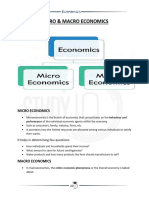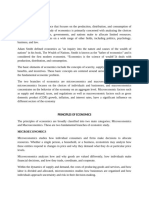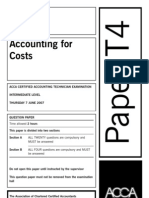Economics Project Lina 12A PDF
Economics Project Lina 12A PDF
Uploaded by
lina atyaniCopyright:
Available Formats
Economics Project Lina 12A PDF
Economics Project Lina 12A PDF
Uploaded by
lina atyaniOriginal Title
Copyright
Available Formats
Share this document
Did you find this document useful?
Is this content inappropriate?
Copyright:
Available Formats
Economics Project Lina 12A PDF
Economics Project Lina 12A PDF
Uploaded by
lina atyaniCopyright:
Available Formats
Why Macro Economics approach is better than
Micro Economics approach?
Have you ever thought what does economics mean? Economics is a social science that
focuses on the production, distribution, and consumption of goods and services, and
analyzes the choices that individuals, businesses, governments, and nations make to allocate
resources.
Macro and micro is one of the economic types. There is a big difference between micro and
macro, there are so many examples that clarifies them.
Macroeconomic is the branch of economics that deals with the structure, performance,
behavior, and decision-making of the whole, or aggregate, economy. It takes a top-down
approach and looks at the economy as a whole.
The two main areas of macroeconomic research are long-term economic growth and
shorter-term business cycles. Example of macroeconomic: Inflation, gross domestic product
(GDP), national income, and unemployment levels.
Microeconomic is a part of economics that contemplates the traits of the decision-makers
within the economy such as households, individuals, and enterprises.
Examples of microeconomic: Consumer equilibrium, individual income and savings.
Microeconomic concepts such as supply and demand affect stocks prices in two ways:
Directly and indirectly.
Why Macro Economics approach is better than Micro Economics approach?
Macroeconomic approach is a way to understand something using a macro perspective, for
example, using aggregate economic variables such as total output, income, and employment.
Microeconomic approach starts with the decisions of an individual about the allocation of
time and income. The credit for the development of the theory of microeconomics approach
is none other than Alfred Marshall. He was one of the most influential economists of his
time.
Macroeconomics has a much broader reach than microeconomics. Prominent areas of
research in the field of macroeconomics concern the implications of fiscal policy, locating
the reasons for inflation or unemployment, the implications of government borrowing and
economic growth on a nationwide scale. Macroeconomists also examine globalization and
global trading patterns and perform comparative studies between different countries in
areas such as living standards and economic growth.
Microeconomics focuses on the behavior of small units of the economy, it tends to limit
itself to specific and specialized areas of study. This includes the balance of supply and
demand in individual markets, the behavior of individual consumers, workforce demand,
and how individual companies determine wages for their workforces.
It is worth mentioning that classical economic theory of Adam Smith, Ricardo, Malthus
and J.S. Mill was mainly macro-analysis, for they discussed the determination of growth of
national income and wealth, the division of national income among broad social classes
(total wages, total rent and total profits), the general price level and the effects of technology
and population increase on the growth of the economy.
On the other hand, neo-classical economics, in which writings of Pigou and Marshall
predominate, is mainly micro-analysis. Neo-classical writers assumed that full- employment
of resources prevailed in the economy and concentrated mainly upon showing how the
resources were allocated to the production of various goods and how the relative prices of
products and factors were determined.
Macroeconomics focuses on the performance of economies – changes in economic output,
inflation, interest and foreign exchange rates, and the balance of payments. Poverty
reduction, social equity, and sustainable growth are only possible with sound monetary and
fiscal policies.
For the conclusion, macroeconomics should be carefully distinguished from
microeconomics. It should be noted that microeconomics also does deal with some
“aggregates” but not of the type with which macroeconomics is concerned. Microeconomics
examines the behaviour of the industry in regard to the determination of its product-price,
output and employment, and the industry is an aggregate of the various firms producing the
same or similar product. Macroeconomics is a branch of economics dealing with
performance, structure, behavior, and decision-making of an economy as a whole.
References:
https://www.investopedia.com/ask/answers/012615/how-do-i-differentiate-between-micro-and-macro-economics.asp
https://flexbooks.ck12.org/user:zxbpc2rzcziwmthaz21hawwuy29t/cbook/episd-2019-2020-economics-with-emphasis-on-the-free-
enterprise-system/section/1.11/primary/lesson/microeconomics/
https://byjus.com/commerce/microeconomics-and-macroeconomics/
Done by Lina Hashim Atyani .. Grade: 12A
You might also like
- Business and Ethics Week 4Document32 pagesBusiness and Ethics Week 4Umer IrfanNo ratings yet
- Business and Ethics Week 4Document30 pagesBusiness and Ethics Week 4Umer IrfanNo ratings yet
- What Is EconomicsDocument3 pagesWhat Is EconomicsKyle CastilNo ratings yet
- Economics: Overview, Types, and Economic IndicatorsDocument3 pagesEconomics: Overview, Types, and Economic IndicatorspedroNo ratings yet
- MicroeconomicsDocument9 pagesMicroeconomicsJohnfernando Abalos JuanNo ratings yet
- Eco Sem 3 Unit 1Document3 pagesEco Sem 3 Unit 1UDAY DESWALNo ratings yet
- H L Ahuja Book Chap. 1 - 2Document9 pagesH L Ahuja Book Chap. 1 - 2archana.rosuNo ratings yet
- Lec 1 PDFDocument26 pagesLec 1 PDFhasanklara84No ratings yet
- What Is EconomicsDocument2 pagesWhat Is EconomicsAlyssa QuiambaoNo ratings yet
- Positive and Normative EconomicsDocument13 pagesPositive and Normative EconomicsKajal SinghNo ratings yet
- MicroeconomicsDocument33 pagesMicroeconomicsshamiah.muchesiaNo ratings yet
- Branches of EconomicsDocument8 pagesBranches of Economicsralph andrew marcalinasNo ratings yet
- ECON1101 Coursework AssignmentDocument7 pagesECON1101 Coursework AssignmentMiki MehreteabNo ratings yet
- Introductory MacroeconomicsDocument19 pagesIntroductory MacroeconomicsMin Bahadur ThapaNo ratings yet
- Microeconomics - Policy AnalysisDocument14 pagesMicroeconomics - Policy AnalysisGaudencio MembrereNo ratings yet
- Foe Unit 1Document30 pagesFoe Unit 1Saravanan ShanmugamNo ratings yet
- Introduction To Macroeconomics: 1st Tutorial QuestionsDocument5 pagesIntroduction To Macroeconomics: 1st Tutorial QuestionsBISHAASH বিশ্বাসNo ratings yet
- Economic Planning and StrategiesDocument5 pagesEconomic Planning and StrategiesMark Gennesis Dela CernaNo ratings yet
- ECONOMICS Lec # 1Document11 pagesECONOMICS Lec # 1duaNo ratings yet
- Micro and Macro EconomicsDocument6 pagesMicro and Macro EconomicsSiva KumarNo ratings yet
- Macroeconomics StudentsDocument2 pagesMacroeconomics StudentsГордей ПолищукNo ratings yet
- UniversityDocument3 pagesUniversityithankhan0No ratings yet
- What Is Economics?: Macroeconomics MicroeconomicsDocument8 pagesWhat Is Economics?: Macroeconomics MicroeconomicsAnonymous tXTxdUpp6No ratings yet
- Interdependence Between Macro and Micro EconomicDocument2 pagesInterdependence Between Macro and Micro Economiclearningkeep7No ratings yet
- Economics NotesDocument13 pagesEconomics Notesbabydollhasina721No ratings yet
- English PDFDocument8 pagesEnglish PDFzakizikouchelliNo ratings yet
- Economic DevelopmentDocument21 pagesEconomic Developmentguintog17No ratings yet
- Economics I ProjectDocument14 pagesEconomics I ProjectGoldy SinghNo ratings yet
- Tourism EconomicsDocument50 pagesTourism EconomicsSameer DNo ratings yet
- MICROECONOMICS AND MACROECONOMICS Hardcopy 1Document5 pagesMICROECONOMICS AND MACROECONOMICS Hardcopy 1Michole chin MallariNo ratings yet
- Basic Concept of EconomicsDocument8 pagesBasic Concept of Economicsthess franciscoNo ratings yet
- EconomicsDocument3 pagesEconomicsMikaNo ratings yet
- Eco Notes 1Document9 pagesEco Notes 1Neha NehaNo ratings yet
- Micro & Macro EconomicsDocument6 pagesMicro & Macro EconomicsSohaibakhtar007No ratings yet
- Macroeconomics Topic 1 LectureDocument11 pagesMacroeconomics Topic 1 LectureКатеринаNo ratings yet
- Macroeconomics-WPS OfficeDocument2 pagesMacroeconomics-WPS OfficeLeon Dela TorreNo ratings yet
- Macro Economics Analysis Unit I: National Income AccountingDocument263 pagesMacro Economics Analysis Unit I: National Income AccountingMasroor ahmed bhatNo ratings yet
- Micro-Economics 2nd Year 1st Semester: 1. Microeconomics 2. MacroeconomicsDocument2 pagesMicro-Economics 2nd Year 1st Semester: 1. Microeconomics 2. Macroeconomicsজয় সোমNo ratings yet
- Unit 1Document30 pagesUnit 1FakeNo ratings yet
- Micro and Macro EconomicsDocument3 pagesMicro and Macro EconomicsTaiba GulNo ratings yet
- Microeconomics vs. Macroeconomics Microeconomics MacroeconomicsDocument3 pagesMicroeconomics vs. Macroeconomics Microeconomics MacroeconomicsruthNo ratings yet
- Principles of Economics - WPS Office-1Document5 pagesPrinciples of Economics - WPS Office-1jilbykjacob1996No ratings yet
- Combined Macro SlidesDocument263 pagesCombined Macro SlideskwamecalculusNo ratings yet
- GC03 - I-Economic ConceptsDocument18 pagesGC03 - I-Economic Conceptsswati chaturvediNo ratings yet
- Module 1Document10 pagesModule 1Hannah AbalecioNo ratings yet
- ASSIGNMENTDocument24 pagesASSIGNMENTKalpana BisenNo ratings yet
- I Module EconomicsDocument28 pagesI Module EconomicsTariq HussainNo ratings yet
- Economic Self-Study GuideDocument16 pagesEconomic Self-Study GuideDanielChihalauNo ratings yet
- Macroeconomics Dde PDFDocument253 pagesMacroeconomics Dde PDFPankaj GahlautNo ratings yet
- 1.0 Definition of Macroeconomic: Macroeconomics GDP Balance MicroeconomicsDocument4 pages1.0 Definition of Macroeconomic: Macroeconomics GDP Balance MicroeconomicsCrystal TanNo ratings yet
- Befa Unit1 NotesDocument47 pagesBefa Unit1 Notessrujansai04No ratings yet
- Macroeconomics DefinitionDocument12 pagesMacroeconomics DefinitionGerald HandersonNo ratings yet
- What Is Economics?: Key TakeawaysDocument1 pageWhat Is Economics?: Key TakeawaysFatima TawasilNo ratings yet
- Chapter 1. - EconomicsDocument5 pagesChapter 1. - EconomicsNaragsak A PabuyaNo ratings yet
- Bcom 206Document45 pagesBcom 206ksucheta013No ratings yet
- ECONOMIC DEVELOPMENT Prelim ModulesDocument13 pagesECONOMIC DEVELOPMENT Prelim ModulesShaira Mae DausNo ratings yet
- Macro Economics For Business Decisions.Document16 pagesMacro Economics For Business Decisions.VrkNo ratings yet
- Eco Prakash PDFDocument10 pagesEco Prakash PDFPanwar SurajNo ratings yet
- BBA 104: Business Economics - II: Course ContentsDocument54 pagesBBA 104: Business Economics - II: Course Contentskunal kushwahNo ratings yet
- Economics Work Sheet 1 For Home Work PDFDocument3 pagesEconomics Work Sheet 1 For Home Work PDFlina atyaniNo ratings yet
- Bio Ws PDFDocument3 pagesBio Ws PDFlina atyaniNo ratings yet
- E Project Worksheet PDFDocument4 pagesE Project Worksheet PDFlina atyaniNo ratings yet
- E Ws 4quarter PDFDocument3 pagesE Ws 4quarter PDFlina atyaniNo ratings yet
- Carbonyl Compounds PDFDocument2 pagesCarbonyl Compounds PDFlina atyaniNo ratings yet
- Worksheet Immune Response (2) ElyDocument7 pagesWorksheet Immune Response (2) Elylina atyaniNo ratings yet
- Leaving Disasters Behind: A Guide To Disaster Risk Reduction in EthiopiaDocument12 pagesLeaving Disasters Behind: A Guide To Disaster Risk Reduction in EthiopiaOxfamNo ratings yet
- Rodamas Case - Syndicate 6Document32 pagesRodamas Case - Syndicate 6Damar HutomoNo ratings yet
- Get Good With MoneyDocument2 pagesGet Good With MoneyVANI RANJITHNo ratings yet
- GG Product MasterDocument10 pagesGG Product MasterMikey RomanovNo ratings yet
- Material Portfolio Manglore TilesDocument14 pagesMaterial Portfolio Manglore TilesSushma KMNo ratings yet
- Inam Ul Haq: Account StatementDocument3 pagesInam Ul Haq: Account StatementHamza NajamNo ratings yet
- Ps Adapter v18 96 enDocument8 pagesPs Adapter v18 96 enWilliamZabaletaNo ratings yet
- Provincial Gazette Provinsiale Koerant: Free State Province Provinsie VrystaatDocument29 pagesProvincial Gazette Provinsiale Koerant: Free State Province Provinsie VrystaatThandi85No ratings yet
- Answer CBM Ch2Document5 pagesAnswer CBM Ch2Visal ChinNo ratings yet
- YPD Guide Executive Summary PDFDocument2 pagesYPD Guide Executive Summary PDFAlex FarrowNo ratings yet
- Is Utilities Overview1Document31 pagesIs Utilities Overview1GeetikaNo ratings yet
- Travel and Expense Management System: Rishika Bhatia Intern - IT UPES, DehradunDocument41 pagesTravel and Expense Management System: Rishika Bhatia Intern - IT UPES, DehradunRishika BhatiaNo ratings yet
- Module 1 - Overview of Financial System - UAEDocument44 pagesModule 1 - Overview of Financial System - UAESonali Jagath100% (1)
- ECO235+Week+2 Topic+1 Linear+mathematical+economic+problems-1Document41 pagesECO235+Week+2 Topic+1 Linear+mathematical+economic+problems-1mindofakira756No ratings yet
- 4 2007 Jun QDocument9 pages4 2007 Jun Qapi-19836745No ratings yet
- EconimicsDocument9 pagesEconimicswiamNo ratings yet
- Fno List Lot Size Update-2024Document23 pagesFno List Lot Size Update-2024NikhilNo ratings yet
- Hni 72Document1 pageHni 72Arsh AhmadNo ratings yet
- Commission Agreement For Tenant PlacementDocument1 pageCommission Agreement For Tenant PlacementDouglas WiesenthalNo ratings yet
- ToeflDocument1 pageToeflConan EdogawaNo ratings yet
- Market Efficiency and Market FailureDocument24 pagesMarket Efficiency and Market FailurePamela SantosNo ratings yet
- Mattel Toys Recall Case StudyDocument5 pagesMattel Toys Recall Case StudyKhadija Fatima100% (1)
- Safety On Working Near Live TrackDocument21 pagesSafety On Working Near Live TrackSafety ExpertNo ratings yet
- Colonialism Neocolonialism Cause of Africas Underdevelopment A Shot in The Wrong DirectionDocument18 pagesColonialism Neocolonialism Cause of Africas Underdevelopment A Shot in The Wrong DirectionMohd Noor FakhrullahNo ratings yet
- Perincian Pembayaran Uli MT Week 15Document10 pagesPerincian Pembayaran Uli MT Week 15Zizul Nur azizahNo ratings yet
- 159 Accrediated Expired As On 28042022Document15 pages159 Accrediated Expired As On 28042022Rushiraj PatelNo ratings yet
- Format - Travelling Allowance BillDocument3 pagesFormat - Travelling Allowance BillSurykant Singhania0% (2)
- Kutch DevelopmentDocument184 pagesKutch Developmentdhara_kidNo ratings yet
- Chapter 20 - Short-Term Financing PDFDocument20 pagesChapter 20 - Short-Term Financing PDFmohamed saedNo ratings yet
- Annual Procurement PlanDocument2 pagesAnnual Procurement PlanMelody Frac Zapatero100% (2)































































































